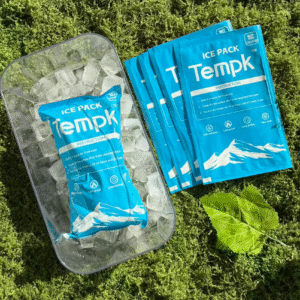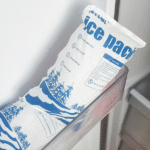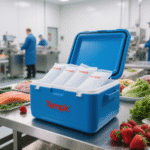What’s the Maximum Dry Ice per Package Allowed?
El maximum dry ice per package allowed depends on mode and operator rules. In air cargo, it’s up to 200 kg por paquete; in passenger baggage, es 2.5 kg per person; USPS air caps a mailpiece at 5 lb. You still need vented packaging, Marcado UN1845, and the right AWB text to pass acceptance. This article consolidates the latest 2025 compliance guidelines and practical cold chain advice.

-
Legal limits by mode con el maximum dry ice per package allowed for common scenarios
-
Embalaje, etiquetado, y ventilación so handlers clear your shipment fast
-
A quick calculator approach to size dry ice without overpacking
-
Carrier variations and how to avoid rejections on specific lanes
-
2025 tendencias that influence safety, costo, y sostenibilidad
What is the maximum dry ice per package allowed in 2025?
Respuesta corta: Arriba a 200 kg per package for air cargo, 2.5 kg in passenger baggage, y ≤ 5 lb for USPS air. Ground has no single national cap; follow packaging, desfogue, and carrier weight/SOP limits. Always confirm operator variations before you ship. The same package can be legal on cargo but restricted on a passenger route.
Por que importa: A single wrong number on your label or AWB can hold freight at tender. Treat 200 kg as a global ceiling, not a guarantee. Your packaging must vent CO₂ and display UN1845, el nombre de envío adecuado, y kg neto de hielo seco en la caja.
How do operator variations change the maximum dry ice per package allowed?
Airlines, express carriers, and postal services can set tighter limits. Common examples include lower per-package caps on some fleets, per-hold totals, and service-level restrictions. Plan your pack-out for the maximum dry ice per package allowed on that exact service and lane, not just the IATA headline rule.
| Modo / Servicio | Límite (typical) | Key rule you must meet | Lo que significa para ti |
|---|---|---|---|
| Carga aérea (UN1845) | 200 kilos / paquete | Desfogue + UN1845 + Kg neto + Texto AWB | Utilizar cargadores validados; imprimir exact net kg |
| Equipaje de pasajeros | 2.5 kilos / pasajero | Airline approval + desfogue + calificación | Fine for short trips; not for bulk payloads |
| USPS air mailpiece | ≤ 5 lb | Solo aire doméstico + desfogue + etiqueta | Need more? Use surface/ground or cargo |
| Domestic ground (A NOSOTROS.) | No national kg cap | Embalaje + carrier SOP | Follow carrier weight limits (p.ej., ≤ 150 lb/package) |
Consejos prácticos y victorias rápidas
-
Print net kg, not “approx.” Align box, docs, and e-AWB values.
-
Nunca selle herméticamente. La ventilación es obligatoria.
-
Sobrecarga: Marks must remain visible; never “hide” UN1845 and net kg.
Case in point: A biotech shipper cut spoilage by 40% after adding CO₂/temperature loggers and right-sizing per-package limits, then aligning labels and AWB entries with operator checklists.
How to calculate the maximum dry ice per package allowed for your lane?
Idea central: Match duration × sublimation rate × safety buffer. Use validated data for your container.
Fórmula rápida:
hielo seco (lb) = (Transit hours ÷ 24) × daily sublimation rate × buffer (1.1–1.2)
-
Typical rates (24 h): Excellent foam shipper 4–6 lb; good plastic 6–8 lb; lined carton 8–10 lb.
-
Ejemplo: 48 h in a foam shipper at ~5–6 lb/day → 10–12 lb, plus 10–20 % buffer.
-
Reality check: Hot lanes, customs holds, and re-sorting increase consumption.
| Planning input | rango típico | What to enter | Por qué te importa |
|---|---|---|---|
| Transit duration | +24–120h | Add 1-day buffer | Delays are common |
| Daily loss (espuma) | 4–6 lb/24 h | Use worst-case | Prevent under-packing |
| Ambient risk | Leve / Caliente | +10–20% in heat | Lane-specific safety |
| Hielo seco neto (kilos) | Calculated | Put exact kg on box | Pase la aceptación por primera vez |
Consejos procesables
-
Short haul: Compact foam shipper with 2–6 kg often holds 24–36 h when pre-chilled.
-
Long haul: Combine dry ice with PCM for smoother temperature control.
-
High value: Add CO₂ and temperature sensors; set alerts for trend breaks.
Labeling and packaging for the maximum dry ice per package allowed
Haz esto cada vez: UN1845, "Hielo seco" o "dióxido de carbono, Sólido,” net weight (kilos) en la caja exterior, Clase 9 etiqueta, vented design, y corregir Línea AWB. Sin sellos herméticos. This is the fastest way to clear carrier acceptance with the maximum dry ice per package allowed.
Acceptance checklist:
-
Ventilado, robust outer + insulated inner.
-
UN1845 + nombre propio + Kg neto printed on box side.
-
Clase 9 etiqueta visible; marks not covered by tape or overpack skins.
-
AWB shows UN1845, Número de paquetes, y net kg per package.
-
Training up to date; use e-DGD where required.
Carrier differences: when the maximum dry ice per package allowed changes
-
Courier air: Many services cap packages below 200 kilos, often 2.5–20 kg.
-
USPS: ≤ 5 LB por aire; more must go ground.
-
UPS/FedEx/DHL: Follow IATA rules but check service-level SOPs.
-
Suelo: Follow packaging and operator weight limits; no single national cap.
Pro move: Build a one-page SOP per lane listing the maximum dry ice per package allowed, AWB line format, y lista de verificación de aceptación.
2025 updates shaping the maximum dry ice per package allowed
Qué hay de nuevo: Digital acceptance and documentation are now standard. Esperar e-DGD, lane-specific operator caps, and tighter sobresalto marking checks. Smart vent plugs and CO₂-aware packaging reduce pressure risk while cutting waste. Growing pharma and biologics demand favors validated foam/VIP kits and hybrid dry-ice + PCM designs.
Último de un vistazo
-
e-DGD & listas de verificación reduce paperwork errors.
-
Variaciones del operador: 200 kg is the ceiling; check per-fleet limits.
-
Sostenibilidad: CO₂ recovery and lighter shippers lower cost.
Insight del mercado: Teams that validate pack-outs with data loggers often cut dry ice use by 10–20% while staying compliant.
Preguntas frecuentes: common compliance questions about the maximum dry ice per package allowed
Q1: What is the maximum dry ice per package allowed for air cargo?
Arriba a 200 kg por paquete, con ventilación, Marcado UN1845, y texto de AWB correcto. Operators may set lower limits.
Q2: How much can I carry in passenger baggage?
2.5 kilos (5.5 lb) per passenger/package, airline approval required, and the container must vent.
Q3: What does USPS allow by air?
≤ 5 lb per mailpiece for domestic air; heavier amounts must go surface/ground or cargo.
Q4: ¿Necesito la declaración de un remitente??
No cuando el hielo seco enfría mercancías no peligrosas; do include the UN1845 line on the AWB. If cooling dangerous goods, a declaration applies.
Q5: What happens if I exceed an operator’s cap?
Expect rejections, delays, or penalties. Always weigh and declare net kg correctly.
Resumen & recomendaciones
Recordar: El maximum dry ice per package allowed es 200 kilos in air cargo, 2.5 kilos in baggage, y 5 lb for USPS air. Use vented packaging, imprimir UN1845 y Kg neto, and align AWB text to the booked service. Validate pack-outs with data to avoid over- or under-packing. Build lane-specific SOPs to ensure every shipment clears first time.
Siguientes pasos:
-
Confirm the carrier/service cap.
-
Use the calculator to size ice.
-
Print exact Kg neto on box and AWB.
-
Pilot with data loggers.
-
Review your training quarterly.
Internal links you can add
-
Dry Ice Labeling Guide (UN1845 & Clase 9) → /knowledge/dry-ice-labeling-un1845
-
How to Build a 48-Hour Frozen Pack-Out → /knowledge/48h-frozen-packout
-
Validated Foam Shipper Sizing Calculator → /tools/shipper-sizing-calculator
-
Hybrid Cooling: Hielo seco + PCM → /knowledge/dry-ice-plus-pcm
-
AWB Examples for Dry Ice → /resources/dry-ice-awb-examples
Engagement boosters
-
Decision widget: “How much dry ice can I legally use?" (mode / carrier inputs)
-
Self-check quiz: “Can this package fly?" (5 yes/no checks)
-
Downloadable checklist: “Dry ice acceptance walk-through (2025)."
Acerca de Tempk
We help you ship frozen and refrigerated products safely and compliantly. Our validated foam/VIP shippers, dry-ice packs, and monitoring options keep lanes stable for 24–120 hours while meeting labeling and venting rules. We combine packaging science with hands-on lane design to shorten acceptance times and cut waste.
Llamado a la acción: Want a 10-minute pack-out review? Talk to a cold-chain specialist.























